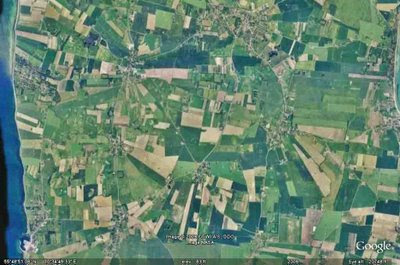Here's a random part of rural England, from about 20,000 feet up.
 See what I mean? It's a jigsaw of interlocking field boundaries that follow and adapt to the contours of the land.
See what I mean? It's a jigsaw of interlocking field boundaries that follow and adapt to the contours of the land.I suppose this tells a story of a land that's owned by lots of individuals who have carved things up, sold and bought little bits to each other, etc. But it was never really a blank canvas. Not for millenia. If I wanted to make a road or a fence, I had to take into account what was already there.
But the US is a different kettle of fish.
This picture is taken from about the same height above ground level.
 Notice how regular it all is? It's arranged on a grid pattern, aligned to the cardinal points (the verticals go north-south, the horizontals go east-west) and it goes on and on for miles and miles and miles in every direction. Within those squares, there is some variety, but not to anything like the same degree that you'd find in England, or for that matter, Europe, where strip fields seem to be more in vogue.
Notice how regular it all is? It's arranged on a grid pattern, aligned to the cardinal points (the verticals go north-south, the horizontals go east-west) and it goes on and on for miles and miles and miles in every direction. Within those squares, there is some variety, but not to anything like the same degree that you'd find in England, or for that matter, Europe, where strip fields seem to be more in vogue.Also, irrigation is much in evidence. Take a big square, put a squirty thing in the middle of it, and you end up with a big square with a nice fertile circle in the middle of it.
Like this bit, taken from about 20,000 feet above the ground in Colorado:

Equally this must tell a tale. Take a land and colonise it and you get to put a pragmatic and efficient structure in place. The people that built America didn't have the same constraints as people in Europe, and this is the result.
I do have more to write on this post, covering Europe and the rest of the world. I'm not an agriculture expert. I just find the differences interesting. Once spotted, you really can't miss the patterns.
Finally, here's an equally startling (in it's own way) pattern of fields from Denmark. I can't find the particular one I was looking for, but again, a discernable pattern exists. In this case, the fields radiate out from the villages, like the rays of the sun or the spokes of a wheel. Blame the vikings for that one. Forever messin' around on bikes, the buggers.

No comments:
Post a Comment